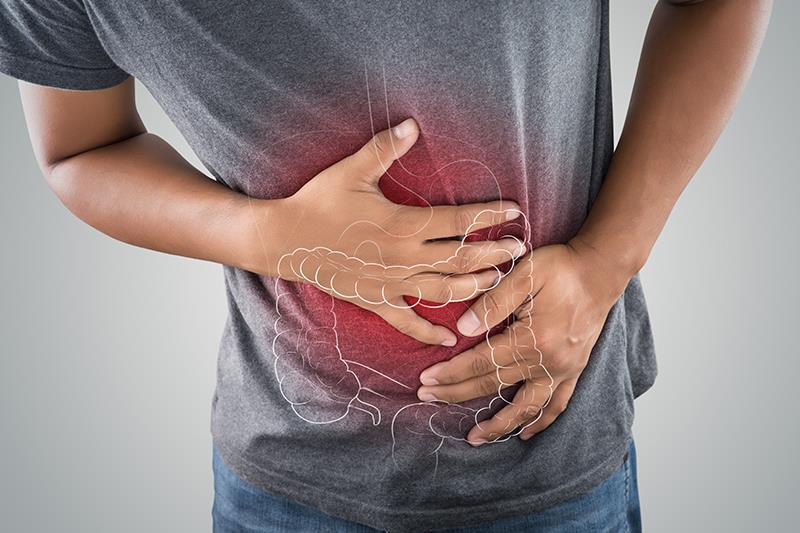Risankizumab induction, maintenance therapy improves clinical remission in UC





Induction and maintenance treatment with risankizumab significantly improved the rates of clinical remission in adults with moderate-to-severe active ulcerative colitis (UC), according to two phase III randomized clinical trials.
The INSPIRE (induction trial) and COMMAND (maintenance trial) cohorts consisted of 975 (mean age 42.1 years, 60.1 percent male) and 548 (mean age 40.9 years, 57.1 percent male) patients, respectively, with moderate-to-severe UC. [JAMA 2024;doi:10.1001/jama.2024.12414]
In the induction trial, participants were randomized in a 2:1 ratio to receive either IV risankizumab 1,200 mg (n=650) or placebo (n=325) at weeks 0, 4, and 8.
In the maintenance trial, those who had an adequate clinical response to risankizumab during induction (INSPIRE trial) were then randomized in a 1:1:1 ratio to receive SC risankizumab 180 mg (n=179) or 360 mg (n=186) or placebo (n=183) every 8 weeks for an additional 52 weeks.
The primary endpoint of the study was clinical remission (per adapted Mayo score, defined as stool frequency score ≤1 and not greater than baseline, rectal bleeding score of 0, and endoscopic subscore ≤1 without friability) at 12 weeks for the induction trial and at 52 weeks for the maintenance trial.
INSPIRE induction trial
At week 12, a significantly higher percentage of patients treated with risankizumab achieved clinical remission than those treated with placebo (20.3 percent vs 6.2 percent; p<0.001), with a significantly higher clinical response rate (64.3 percent vs 35.7 percent; p<0.001).
Significantly more risankizumab-treated patients also achieved the secondary endpoints of endoscopic improvement and remission at week 12 (36.5 percent vs 12.1 percent and 10.6 percent vs 3.4 percent, respectively; p<0.001 for both) than the placebo-treated patients.
Histological, endoscopic, and mucosal improvements (24.5 percent vs 7.7 percent; p<0.001) and remissions (6.3 percent vs 0.6 percent; p<0.001) at week 12 were also observed in the risankizumab arm than in the placebo arm.
Risankizumab recipients also demonstrated a significant improvement in patient-reported outcomes, including the absence of bowel urgency (44.1 percent vs 27.7 percent; p<0.001), abdominal pain (35.8 percent vs 26.5 percent; p=0.002), and nocturnal bowel movements (67.3 percent vs 43.1 percent; p<0.001), than the placebo recipients.
Moreover, treatment with risankizumab was associated with significant improvements in fatigue and health-related quality of life, as shown by higher FACIT-F* (7.9 vs 3.3; p<0.001) and IBDQ** scores (42.6 vs 24.3; p<0.001 for both), respectively, from baseline to week 12 compared with placebo.
COMMAND maintenance trial
At week 52, significantly more patients treated with either dose of risankizumab achieved clinical remission than those treated with placebo (40.2 percent; p<0.001 [180 mg] and 37.6 percent; p=0.002 [360 mg] vs 25.1 percent).
The clinical response rate was also significantly higher in the risankizumab arm than in the placebo arm (68.2 percent; p<0.001 [180 mg] and 62.3 percent; p=0.02 [360 mg] vs 51.9 percent).
Furthermore, secondary endpoints of endoscopic improvement and remission, as well as histological, endoscopic, and mucosal improvements were also observed with risankizumab as compared with placebo during the maintenance trial, similar to those observed in the induction trial.
“Taken together, in the induction trial, treatment with risankizumab improved endoscopic and histological secondary outcomes characterized by endoscopic improvement; endoscopic remission; and histological, endoscopic, and mucosal improvement. These improvements were also observed in the maintenance trial,” noted the researchers.
Safety endpoints
Compared with placebo recipients, those on risankizumab had fewer serious adverse events (AEs) both in the induction (2.3 percent vs 10.2 percent) and maintenance trials (5.2 percent [180 mg] and 5.1 percent [360 mg] vs 8.2 percent).
During the induction trial, COVID-19 and anaemia were the most common AEs reported in the risankizumab group, while UC and anaemia were reported in the placebo group.
The most common AEs reported during the maintenance trial were UC and COVID-19 in both treatment groups.
Overall, risankizumab improved clinical remission rates for patients with moderately to severely active UC in both induction and maintenance trials compared with placebo, the researchers concluded.
“However, further study is needed to identify benefits beyond the 52-week follow-up,” they stated.